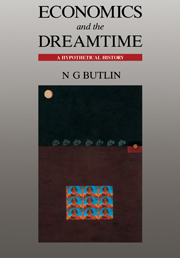Book contents
- Frontmatter
- Contents
- Preface
- Acknowledgements
- Figures
- Maps
- Tables
- Introduction
- Part I The palaeoeconomic history of Aboriginal migration
- Part II Development, structure and function of Aboriginal economy
- Part III Disease, economics and demography
- Part IV The establishment of a bridgehead economy: 1788–1810
- Part V The takeover process: 1788–1850
- 19 Introduction
- 20 British development in the long run
- 21 The hunter gatherers of empire
- 22 British, American and Macassan presence in the takeover
- 23 The major players
- 24 Aborigines and British law
- 25 The economics of takeover
- 26 The composition and demographic impact of disease
- 27 The interaction of disease with resistance, integration and submission
- 28 Conclusions
- Bibliography
- Appendix 1 Preliminary model/checklist of Aboriginal migration to Australia
- Appendix 2 NOAA depth contour maps
- Index
26 - The composition and demographic impact of disease
Published online by Cambridge University Press: 06 July 2010
- Frontmatter
- Contents
- Preface
- Acknowledgements
- Figures
- Maps
- Tables
- Introduction
- Part I The palaeoeconomic history of Aboriginal migration
- Part II Development, structure and function of Aboriginal economy
- Part III Disease, economics and demography
- Part IV The establishment of a bridgehead economy: 1788–1810
- Part V The takeover process: 1788–1850
- 19 Introduction
- 20 British development in the long run
- 21 The hunter gatherers of empire
- 22 British, American and Macassan presence in the takeover
- 23 The major players
- 24 Aborigines and British law
- 25 The economics of takeover
- 26 The composition and demographic impact of disease
- 27 The interaction of disease with resistance, integration and submission
- 28 Conclusions
- Bibliography
- Appendix 1 Preliminary model/checklist of Aboriginal migration to Australia
- Appendix 2 NOAA depth contour maps
- Index
Summary
In 1971, D. Barwick produced an excellent study of the mortality records of Victorian Aborigines who died between 1876 and 1912. She also made a study of the age structure and sex composition of tribal remnants in 1863, allowing a projection back of dates of birth. This study showed high mortality at early ages, high infant mortality and generally poor health conditions for ‘protected’ Aborigines throughout the period. Low birth rates (imputed back to the early nineteenth century) were ascribed to the prominence of venereal disease, which was prevalent until the 1850s, and the overwhelming cause of death for adults was respiratory disease. Liver, gastric and heart disease, along with a general category of ‘infectious’ diseases, were also significant.
Barwick's study related to experience after the British takeover was completed. But it quantified and generally conformed to the comments by British settlers and protectors before 1850 — widespread venereal disease, early age mortality related to venereal, respiratory and other infectious diseases, low birth rates together with a sex imbalance in favour of males. The settlers and protectors before 1850 were impressed by the ease with which Aborigines died, as if they had lost the will to live or even ‘willed themselves to die’. This was, apart from Van Diemen's Land, an Australia-wide assessment and applied in south-east Australia, in South and Western Australia, and later in Queensland.
- Type
- Chapter
- Information
- Economics and the DreamtimeA Hypothetical History, pp. 215 - 220Publisher: Cambridge University PressPrint publication year: 1993



